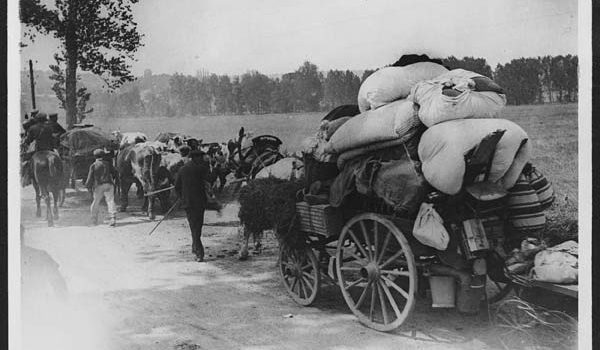Build the Plan vs. Test the Plan – Part 5
by T.R., Survival Blog:

(Continued from Part 4. This part concludes the article series.)
Moving on to drinks as a subject, I prepared a similar smaller “cube” container for drinks and soups. More coffee filter packs, zip lock bags of tea taken out of their cardboard retail packaging, hot cocoa, more honey, powdered lemonade tubs, powdered ice tea, Tang for astronauts or space aliens we might meet (just kidding) that I found in the pantry, instant coffee, another jar of coffee mate, a red plastic Folger’s coffee tub of ground coffee, a few boxes of flavored Emergen-C powders that give you 1000mg of Vitamin C and make flavor choices for plain water to spice things up (took those out of the box and put the little envelopes into zip lock bags), more instant oatmeal, a large bottle of Almond flavored coffee syrup got tossed in from the kitchen counter along with jars of beef bouillon and chicken bouillon.
In camp, when I make canned soup, assuming I don’t have water constraints, I typically double the soup batch by adding a bouillon cube or two to chicken noodle and keep extra bags of dry Egg Noodles in the food pantry. In a pinch, I can make a broth which adds warmth on a cold night or acts as a side dish or appetizer on occasion. I doubled up on Tylenol and Motrin and threw in two extra bottles of pain medicine to duplicate what I had in the first aid kit, added an extra can opener and a few bottles of multi vitamins from the bathroom closet.
By the time I was finished, we had a modular system of containers or carriers. This took almost an entire day, plus part of the next morning. Each one was sealed, with an inventory list tucked inside, and was organized based on the purpose/use and labeled. We had a breakfast canister, a drink canister, a lunch/dinner canister plus a snack bag of loose food & fruit on hand. Perishable food pulled into service that was on hand from our previous regular grocery buys got tossed into a canvas boat bag (to use first since it had a limited shelf life), a red Galls gear bag with a high quality first aid kit from last year’s project list, and then added a few cases of canned chili, canned baked beans, a sack of mixed dry beans which I can add to canned soup to double up their calorie count and pack protein punch, tuna fish, more canned soups, powdered soups (miso and Thai noodles), more peanut butter, Nutella left over from the kids last visit, and a sweep of pantry items from recent grocery trips plus a large sack of basmati rice which we keep in a sealed bucket. The bucket would pull double duty as a dish rinse or camp bucket.
Over time on the road, while there was still daylight, we would pack the canvas boat bag with the next day’s food to complement remaining perishable items and shove it into the car (out of the sight of bears). This forced us to daily eat down initial perishable items and also plan for the next day as well. That certainly helped for a few days where we awoke to pouring rain and thunder; made those days a little simpler and followed our general rule of “no reason to believe tomorrow will be easier, so let’s do what we can today”. On a few days, “tomorrow” actually ended up being much easier due to that planning and, on those days, we treated ourselves to long hikes to waterfalls, canyons, high alpine lakes or vistas with roaming buffaloes. We did bring a few canisters of bear spray; we keep an extra in with the kitchen gear box. I found that having a shallow plastic Hefty brand box from Home Depot worked great for cook gear and stowed fast either in the car or under the webbed cot frame worked great. Shallow plastic tubs that resemble drawer dimensions work way better for kitchen gear than deeper narrow storage bins.
PROVISIONS FOR 30 DAYS?
Our field test protocol was trying to determine whether, in the context of evacuating (aka leaving for vacation), our car/truck capacity could hold enough gear and provisions to last 30+ days. Or could it last more than 30+ days? I’m still plowing through that analysis by hand, however, with future refinements, I think it would be possible to have a few well-planned food canisters plus perhaps one good sized trunk that would go well past 60 days. We have tested out MREs in the past, but my system prefers to make meals for two people by scratch using assembled components of my own much less expensively, with a better-quality product.
I won’t go into the same detail for our camping gear since we typically keep a master list of that on a paper check list which gets scaled up or down based on the season and target destination. However, we did make a few changes here too in terms of pre-staging. We typically camp with our family and kids’ spouses and/or friends. Our group size can range from the two of us all the way upwards to 10-12 or more. It is not feasible for us to escape with provisions for more than 2-3 of us (which is why JWR’s novel Patriots and other stories have pre-staging to a cabin or other location as a key principle).
One lesson learned was to use a silver or gold contrasting color Sharpie and mark each dry bag or container in cubic inches or liter capacity on a seam and then mark each sleeping bag with its’ temperature rating. To speed things up, I bought five Cabela’s magnum size duffel dry bags in khaki/tan colors and packed each of them into a modular set of camping gear for two people per duffel (two sleeping bags, sleeping mats, one tent, one tarp, bug spray, bear spray, recent toiletry kits from airlines in a zip lock bag, a few clothes pins to dry items either inside the tent or on a fly line, a few new toothbrushes, dental floss, a few old dorm quality wash cloths, a small clean beach towel that had seen better days and few men’s T-shirts that were borderline for dust rags but could also be used as camp pot holders or pressed into service if need be, a few old ball caps from little league (dark colors) and old but serviceable long underwear that had been replaced by new versions, an extra roll of duct tape to patch a tent in a pinch).
THE KEY: USING DRY BAGS
Again, I made a list of what’s in each magnum duffel, rolled/buckled each bag closed tight and tossed it into a corner. A cornerstone of our new planning strategy relies on these rubberized Bill’s Bag type stowage, or these Cabela’s dry bags. They can be pre-packed with clean dry gear and mostly with spare clothes and socks that are our size or one size larger (basically, we usually wear a size M so most of our stage gear was a mix of size M and size L). Each of these magnum gear bags would outfit two people for a camp-type environment that would dovetail into a larger team unit (since that larger team unit would need to have the stove, cook gear and food/provisions). Making a list of shared items versus items that get ticked against a head-count person is very helpful. We can envision a situation where we leave gear for others to pick up later and my husband was able to hog tie up to six of these duffel bags on the vehicle roof.
Not having 100% confidence which type of vehicle we might have on hand, we decided to have gear bags staged as HIGH = required, Medium = space available, and Low = optional. That partially worked, but there are some items where we prefer duplication and then other situations where we simply can’t be towing around extras either for weight/space reasons.
My EMT/first aid bags are always packed, always red in color; we keep one in each car and a triplicate inside the house. We had a basic tool kit supplemented by a few items that had been needed on previous camp trips. We had a safety/security range bag stuffed into a non-descript black gym bag. The Cabela’s magnum duffels bag can be strapped onto the vehicle roof since they are waterproof. We had a Yakima Rocket box that is a clamshell like design we used for previous camp trips. Cabela’s dry bags or Bill’s Bags lashed to the roof were much better than the clamshell box in terms of odd sizes and space. Later, as we ate into our food stuffs and that storage requirement shrunk in size, we put some of the duffel bag gear inside the vehicle or rolled up an empty gear bag under the seat.
SECOND TRY AT PACKING STRATEGY
I clipped color-coded carabiners on each bag to indicate Hi, Med, Low and then drew up a map of the basement gear corner. Now, with our tow hitch rack for water and spare gas all pre-staged, combined with the food modules and gear tiering, we tried our packing strategy for the second time. We put items that “were close but no cigar” into a laundry basket; these items did not make the cut by virtue of no space physically OR no room for additional weight OR not needed compared to other items that we deliberately chosen ahead of these picks. Any bag that had safety, security, tools or first aid gear had a color slash of duct tape on the outside. In one of the vehicle doors, we keep 2-3 rolls of duct tape in red, army green and black and each color meant something specific to us.
We were able to pack out faster with more gear and better choices. Overall, this was our best trip ever in terms of fun. Our meals were simple style but really good quality. Our breakfasts were heavy except for long hiking days, and our dinners trended lighter. We tended to graze for lunch or drink hot soup. Nuts and dried fruit were a key snack. Most days we would go hiking and alternate with our EDC packs vs. a full stack top loading backpack for some fitness tests. Staying mostly at National Park camp sites, we were on our “honor system” to not use electricity for any purpose. We took sun showers from lake water.
Loading...



